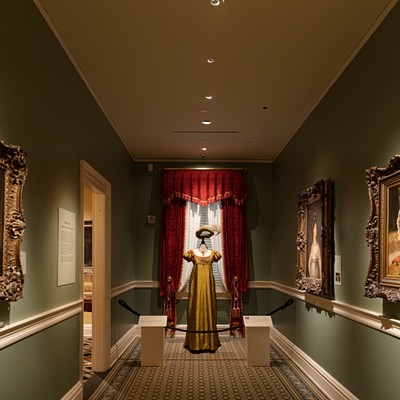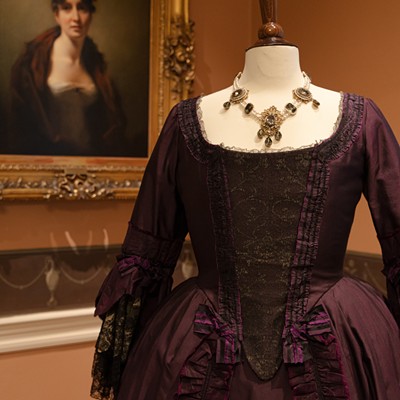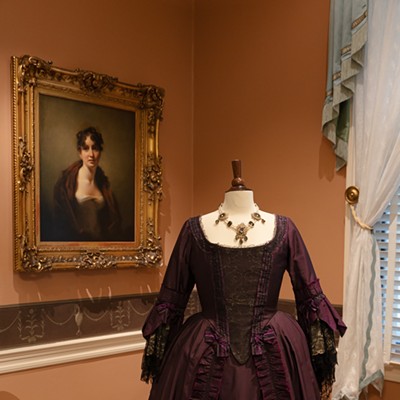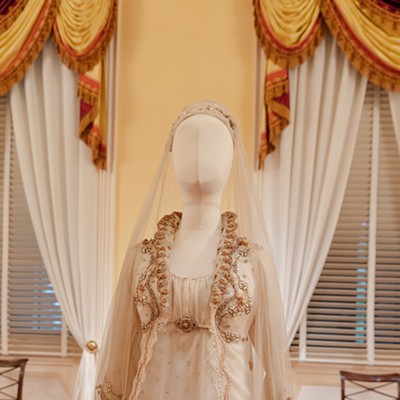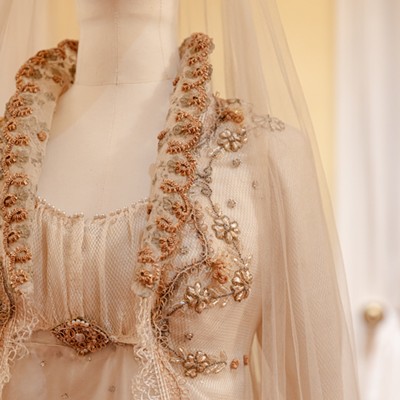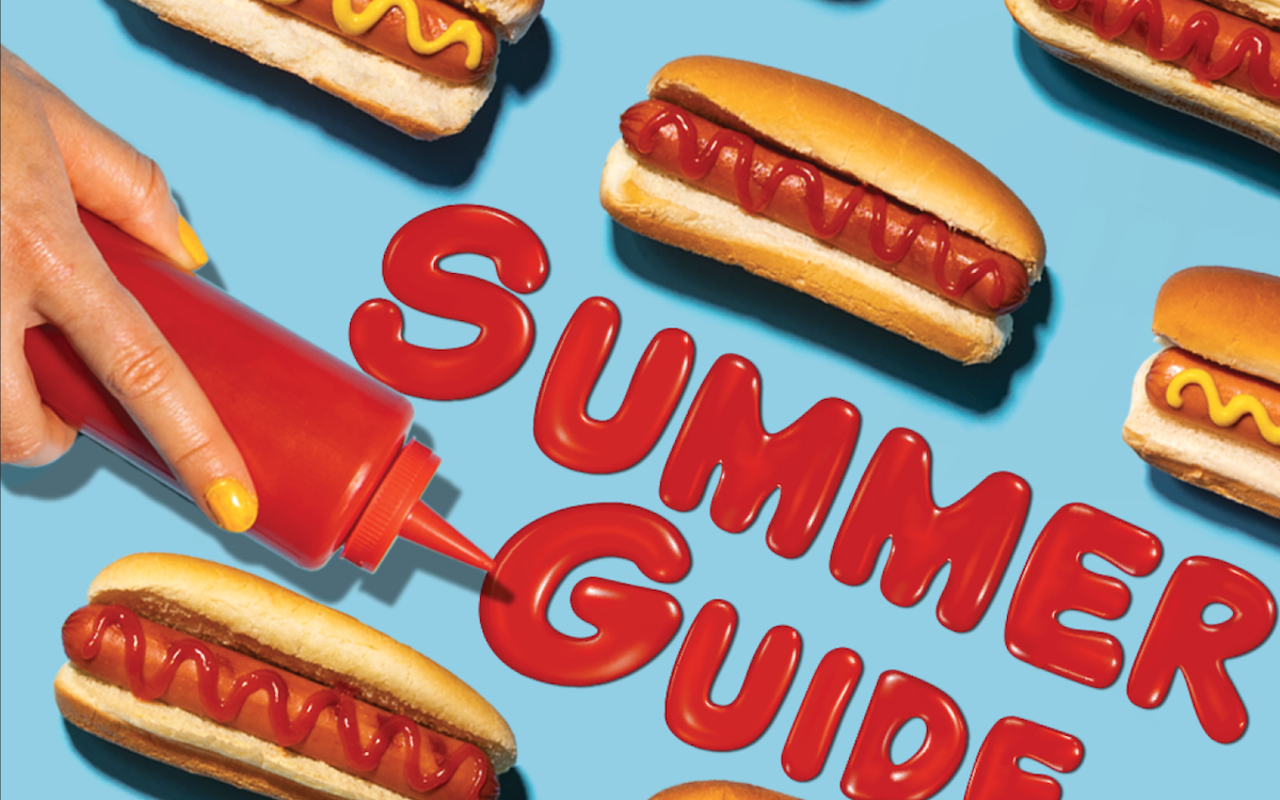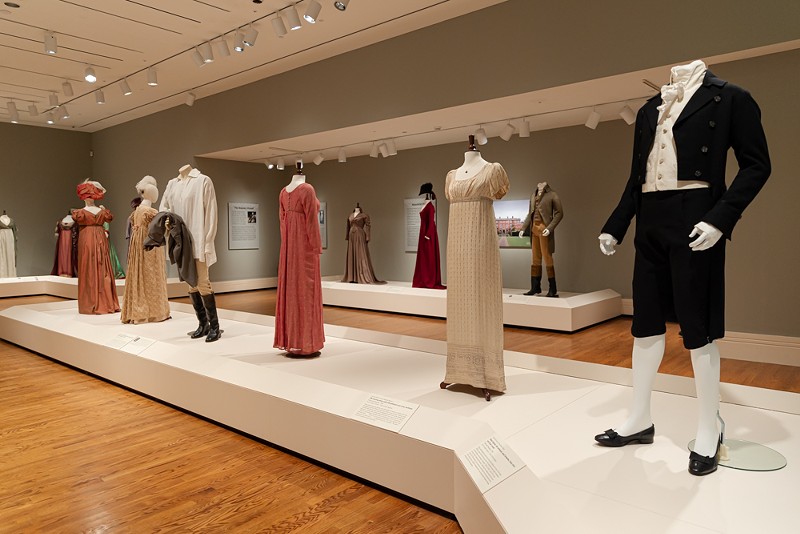
Get ready to promenade at the Taft Museum of Art this summer: Fashion & Sensibility made its North American debut on June 11.
Traveling from London, England, the exhibition features costumes from a number of acclaimed film adaptations of Jane Austen’s beloved novels.
On display in the Fifth Third Gallery and throughout the Taft historic house, the exhibition gives Austen fans the chance to see costumes worn in films like Pride & Prejudice, Emma, Sense & Sensibility and Mansfield Park from the award-winning collection of British costume house Cosprop Ltd. It includes the dusters, capes, tailcoats, trousers, trimmed bonnets, spencers (cropped jackets for women), high-waisted dresses and suits that brought life to beloved characters like Emma Woodhouse, Elizabeth Bennet, the Dashwood Sisters, Mr. Fitzwilliam Darcy, Lady Catherine de Bourgh, Fanny Price, Colonel Brandon and more.
In the Fifth Third Gallery, the costumes are grouped by film; each section includes information not only about the original novel and subsequent adaptation but also the historical context of the Regency Era and the time’s popular fashion. According to Taft curator Tamera Muente, Jane Austen: Fashion & Sensibility also examines how costume designers use dress to visually demonstrate issues present in Austen’s novels, such as the period’s social and class structure.
“One good example – and there are many – is the 1995 BBC series of Pride & Prejudice,” Muente tells CityBeat. For those unfamiliar with the 1813 book, Austen’s Pride & Prejudice follows the five sisters of the Bennet family, and the family’s house is being passed to the closest male relative instead of one of the daughters. That means marrying rich is the family’s only shot at financial stability.
Muente, whose favorite Austen adaptation is Ang Lee’s Sense & Sensibility, comes by her appreciation for Austen’s work naturally. She was an English undergraduate student before receiving an M.A. in art history, and Muente read Austen’s novels while at college in the ‘90s. During a summer trip to London, she pored over Mansfield Park, she says, and while working on the exhibition revisited Austen’s novels and film adaptations.
Muente explains that the BBC series’ costume designer Dinah Collin dressed the sisters with this struggle in mind. According to a label accompanying a day dress worn by Polly Maberly as Kitty Bennet, much of the printed muslin fabric used for the sisters’ dresses was custom-made for the BBC Series.
“Their social and economic status is in contrast with the wealthy Charles Bingley and his sisters who arrive in the country. The story begins there,” Muente says. “The costume designer really used color and fabric to visually represent those class differences. The Bennet sisters are dressed in cotton and pale colors while the Bingley sisters are dressed in silk, bold colors and more exotic high fashion.”
Another example is the 2007 made-for-TV film Mansfield Park. Based on Austen’s 1814 novel, the story is about Fanny Price, a poor girl who is sent to live with her aristocratic aunt and uncle.
Muente explains that Fanny dons outdated clothing in the movie. Her dress is foiled by rival Mary Crawford, a Londoner who was born into high society.
University of Cincinnati professor emerita Barbara Wenner, an Austen expert, also points out this distinction. Wenner will lend her expertise during tours on select days through the exhibition’s September 4 run.
“Fanny comes with an outfit that looks like it’s the 1790s. Obviously, it’s someone’s old outfit. You’ll notice that the waist is not as high (on Fanny’s dress),” Wenner says. “That’s a marker of what was going on in the early 1800s. The waists get higher and higher until there are about four inches above the waistline of fabric. Fanny has an old-fashioned dress on. If you knew anything about it, you’d go, ‘Oh, yeah, she’s out of date.’”
Muente points out that costuming allows viewers to not only differentiate between the characters’ social statuses but their personalities, too. As characters develop and evolve throughout the story, so do their costumes. This development can be seen in the 2005 Pride & Prejudice adaptation starring Matthew Macfadyen as Fitzwilliam Darcy opposite Keira Knightley, who stars as the strong-willed, independent Elizabeth Bennet.
“Mr. Darcy at the beginning is very buttoned up with the high-Regency collars. He’s very stiff,” Muente says. “By the end, he proposes in what is essentially a state of undress. He’s wearing an unbuttoned shirt and a long coat.”
That costume, as worn in the 2005 film Pride & Prejudice, is featured in the exhibition. Designed by Jacqueline Durran, this Mr. Darcy outfit is also part of what is arguably one of the most well-known scenes in the Austen film universe––even for those who aren’t fans.
Having been rebuffed prior, Mr. Darcy approaches Bennet as she strolls through the countryside on an overcast morning. His cotton coat, layered above a loose linen shirt, ruffles in the breeze; the sunrise peaks above the horizon. “You have bewitched me body and soul and I love, I love, I love you,” he confesses before proposing to a softened Elizabeth.
Muente says that scene marks Mr. Darcy’s change in character from a reserved, buttoned-up person to a romantic who is hopelessly in love––an evolution made evident through his costuming. While the exhibition features a large number of costumes from the 1995 version of Pride Prejudice, museum-goers will get to see a few from the 2005 adaptation, as well.
Also included are costumes worn by Kate Winslet, Emma Thompson and others in 1995’s Sense & Sensibility. Two Emma films––one starring Gwyneth Paltrow and the other Kate Beckinsale as the titular character––were released in 1996, and patrons can see items from both. Costumes from Mansfield Park (2007) round out the group.
“It’s been really interesting to learn about the thinking behind how the costumes are going to represent the story,” Muente says. “The 1995 Pride & Prejudice is set around 1813 or so, whereas in the 2005 version, the director (Joe Wright) wanted to set the film in the late 1790s because he wasn’t a fan of the high-waisted Regency dresses. He decided to set the film from the era when Jane Austen wrote her first draft of Pride & Prejudice, around 1797.”
These decisions resulted in each film tackling a different period of dress, and both works received recognition: Jacqueline Durran nabbed an Oscar nomination for costume design in 2005 while Dinah Collin received an Emmy for the ‘90s miniseries, which drew upon styles from 1810-1813. While the costume designers aim to be historically accurate, Muente says they also take liberties to better show class differences, personalities and relationships between characters.
Quotes from Austen’s books and letters can be found throughout the Fifth Third Gallery and along corridors throughout the Taft; an interactive station even allows visitors to pen their own letters. Aside from details about costume design, the exhibition also digs deeper into details about men’s underwear, the various layers women wore under dresses and where they shopped for clothing.
“There’s also historical context about the Regency Era,” Muente says. “There was a lot of upheaval. Even though the fashion was so graceful and elegant, and seems very rational and neoclassical, England was at war through the entire period. Slavery was being debated and was eventually abolished during the Regency period. There’s a lot going on historically––lots of influence from the Middle East and North Africa in fashion. Some of the content of the show gets into that as well.”
Though the Regency Era historically refers to the years between 1811-1820, a panel in the exhibit says that the style stretched from 1795-1825, when all six of Austen’s completed books were published (another remains unfinished). The period is marked by King George III’s deteriorating mental state as his son, the Prince of Wales, ruled as regent.
Visitors can see spots Austen herself frequented while in London via a 7’x13’ map made in 1746, about half a century before she began writing. Housed in the Sinton Gallery, the map is accompanied by two costumes worn by the Dashwood sisters to a ball in London in Sense & Sensibility.
Though many of Austen’s novels are set in the English countryside, this map, lent by the estate of Sallie Robinson Wadsworth, shows London locations from both Austen’s fiction and her personal life. The map includes coordinates marking places such as where she met with her publisher John Murray as well as Twinings, her tea shop of choice. Like several of the locations spotlighted, the latter remains open today. One spot on the map is 10 Henrietta Street, the flat that once belonged to Austen’s brother Henry and where she stayed while visiting London.
Wenner says Austen did much of her revising of Emma while in the city.
“You can see the places that she set her novels for where people lived and you can see where she lived by looking at the map,” Wenner says. “It’s amazingly detailed. You can see all the little streets and the houses and places where they dyed cloth and put them on what they call tender hooks out in the field.”
Fashion & Sensibility’s opening also marks the completion of the museum’s $12.7 million preservation efforts. Titled the Bicentennial Infrastructure Project, the museum broke ground last summer with aims not only to enhance visitor experience but to preserve the 200-year-old building’s exteriors, improve insulation, update its HVAC and security systems and more.
A National Historic Landmark, the Taft was built as a home circa 1820, around the same time that many of Austen’s novels and various film adaptations are set. Muente says the house was built at the tail-end of Regency-style fashion.
“The Regency Era is filled with all these neoclassical influences. So dresses and architecture are inspired by Greek and Roman sculpture,” Muente says. “The Taft House was inspired by just that. It’s a neoclassical building, so it shows the influence of that globally. These fashions were popular in England but also originated in France. It’s why we call those high-waisted dresses empire waistlines––it’s because they originated during the Napoleonic Empire.”
Now visitors can see that influence’s movement from France to England and across the Atlantic Ocean to the United States. Built just three years after Austen’s death, the Taft Museum will give patrons a chance to see costumes inspired by the Regency Era in a historic setting.
On the inside, Muente says visitors will notice changes to the Taft’s permanent collection galleries, with curators developing 200 new labels, renaming galleries, creating fresh designs and moving a few works to new locations.
While working on the exhibition, Muente’s first idea was to put the films’ wedding dresses in the Music Room, where Charles and Anna Taft married on December 4, 1873. According to a historical account on the Taft’s website, the wedding was hailed by the Cincinnati Enquirer as the “social event of the season.”
The show also interweaves costumes with various artworks, such as the dress worn by Judi Dench as the pompous Lady Catherine de Bourgh in the 2005 Pride & Prejudice. The costume is housed in the newly-titled Portraits & Prosperity Gallery, which Muente says is all about how portraiture projects wealth.
“Lady Catherine de Bourgh is super-wealthy. She is wearing this dress that harkens back to the earlier 1790s,” Muente says. “Some of the portraits of women in that gallery are from that era. I think that dress is going to really connect well with art in that space.”
Wenner says she thinks Austen is a great way to welcome people back to a newly-revamped Taft, which she calls a work of art in and of itself – especially as Regency-era romances at large continue to have a prolonged pop-culture moment. Netflix’s Bridgerton series – based on novels by Julia Quinn – became the streaming giant’s most-watched English-language television series when it premiered in 2020. And the mid-1990s saw several Austen adaptations hit silver and small screens. Autumn de Wilde’s 2000 film Emma received great acclaim, even nabbing an Academy Awards nomination for Best Costume Design.
“Jane never goes out of style,” says Candice Hern, a bestselling romance author and popular speaker on Regency and Jane Austen topics. Hern will speak at 6:30 p.m. July 7 at the Taft about fashion and dress in Regency Britain. Her presentation will cover day and evening wear as well as specialty fashions like court dress, riding habits and mourning dress. Hailing from Minneapolis, the talk will mark Hern’s first time in Cincinnati.
Hern says she has collected Regency fashion prints and magazines – of which she has more than 800 – for about 40 years. Her presentation will give audiences a chance to see some of these prints and learn about definitions like “undress,” or clothes one would wear in the comfort of home; “half-dress,” which is somewhere in between, such as afternoon walking dresses; and “full dress,” the attire worn in the late evening or to fancier events.
“Because these are based on the magazines of the period, most of the magazines, and the ones with the most beautiful prints, were expensive,” Hern says. “They were targeted to affluent women. So someone of Jane Austen’s economic, financial situation would not have been able to afford any of these things or have the occasion to wear a ball gown.”
However, Hern says that when ladies of all classes went to a dressmaker, these magazines and prints were used as a guide for what was popular. Just like modern fashion magazines, the trends changed month-to-month, from colors to hemlines and waist placements.
Julia Quinn even called on Hern to reference her collection of prints when she was first writing Bridgerton. Of the show and recent adaptations, Hern thinks their popularity allows younger audiences to experience the genre and, hopefully, inspire them to read Austen’s novels. Now 72-years-old, Hern first read Austen after picking up a paperback copy of Pride & Prejudice at a Scholastic Book Fair when she was 12.
“The journey to getting to those love stories in Jane Austen is all based on character,” Hern says. “They are just some of the wittiest, brilliant bits of dialogue and narrative that you can ever read. I’m a big fan, as you can tell.”
Other programs during Fashion & Sensibility include docent-led tours on select Sundays; afternoon tea in the Taft’s historic garden on select Thursdays (light Regency-inspired bites included); free Cincinnati Chamber Orchestra concerts on June 19, July 17 and August 28; and a bookbinding workshop on August 6, among others.
“There’s just a constant interest in Jane Austen stories and the Regency Era,” Muente says. “I think the timeless nature of her stories is one reason for that.”
Wenner has a similar sentiment, noting that Jane Austen’s works are populated with characters with personalities one would recognize in their own social circles, even in 2022. In daily life, you might see a boasting, foolish woman like Mrs. Elton or run into a Mr. Woodhouse, a chronic worrier preoccupied with health and the weather, both of which are from Emma.
“The books aren’t dated, really,” Wenner says. “If you look at them, and look at the general concerns about money, marriage and society, a lot of them are still things we deal with today. Austen managed to go beyond her era in that.”
Jane Austen: Fashion & Sensibility runs through Sept. 4 at the Taft Museum of Art, 316 Pike St., Downtown. Info: taftmuseum.org/jane-austen.
Stay connected with CityBeat. Subscribe to our newsletters, and follow us on Facebook, Instagram, Twitter, Google News, Apple News and Reddit.
Send CityBeat a news or story tip or submit a calendar event.



